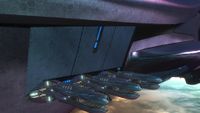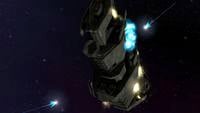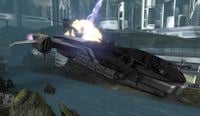Plasma torpedo: Difference between revisions
From Halopedia, the Halo wiki
mNo edit summary |
Sith Venator (talk | contribs) |
||
| Line 91: | Line 91: | ||
*''[[Halo: Mortal Dictata]]'' | *''[[Halo: Mortal Dictata]]'' | ||
*''[[Halo: Escalation]]'' | *''[[Halo: Escalation]]'' | ||
*''[[Halo 2 Anniversary]]'' | |||
==Sources== | ==Sources== | ||
Revision as of 16:57, June 13, 2014
| This article does not have enough inline citations and/or does not adhere to the proper citation format. You can help Halopedia by adding citations. |
- "The Covenant cruiser came about to face them. Its plasma turrets glowed like angry red eyes."
- — Description[1]
The plasma turret, also known as a plasma cannon,[2] is a weapon used by most Covenant warships. It fires magnetically guided bolts of plasma, referred to as plasma torpedoes, and can strike at almost any range.[3] Along with the pulse laser turret and energy projector, it is one of their primary ship-to-ship weapons. Upon contact, a plasma torpedo causes severe damage to the target, boiling armor or overloading shields. The weapon can be used in conjunction with pulse laser turrets and energy projectors to decimate entire UNSC fleets, and can be used in ground assaults as well.[4]
Design details
The turret itself is antenna-like in appearance and is often located along the lateral sides of the ship. The beam is red, purple, or blue and short with a ball-like head and a trail. The turrets, from afar, usually appear as short spikes on the sides, the upper sides, and the bow of the vessel. On larger ships, the plasma is collected into visible lines located along the surface of the exterior hull before firing.[5]
The size and power of the plasma turret depends on the vessel; the plasma turrets mounted on smaller ships such as corvettes are less powerful than those on larger vessels such as battlecruisers. In addition, the plasma turrets mounted on corvettes only appear to be able to fire their torpedoes in a straight line,[6] while the tracking systems on larger warships are far more sophisticated.
Operation
Plasma is heated in a pinched magnetic field by energy supplied from the ship's pinch fusion reactors. The atoms that are on an appropriate trajectory between the Covenant starship and its target are then herded towards the mouth of the turret through a series of plasma conduits by magnetic pulses.[7] Magnetic coils shape and guide the plasma, acting as a sophisticated focusing lens. When the weapon charges, a line of superheated plasma forms alongside the exterior plasma conduit adjoining the turret.[8] Once fully charged, the line detaches and fires outward at its target. The torpedo is guided towards its target by a long-reaching magnetic field projected by the emitter.[9] Upon impact, the torpedo penetrates the target starship, burning through internal decks and structures, thus causing heavy damage on the target.
They are extraordinarily accurate; one of the only ways for UNSC ships to even temporarily avoid them is to use emergency thrusters to "dodge" incoming plasma torpedoes at the last moment. Particularly strong magnetospheres, such as those of gas giants, will disrupt the magnetic field holding the torpedo together, dissipating the plasma and rendering the torpedo harmless.[10][11]
The attacking ship must lower a section of its shield in order to fire the torpedo, otherwise it would detonate inside the protective barrier. John-117 used this weakness to temporarily blind a Covenant cruiser with a Longsword and to penetrate the shields of the Covenant supercarrier Ascendant Justice.
Guidance
Plasma torpedoes are manually guided from a weapons control station on the bridge, by using holographic "steering spheres" superimposed over a holographic display of the space surrounding the ship. The plasma torpedoes and steering solutions of an enemy ship are similarly shown on the display.[12] Covenant corvettes also feature manned control stations from which each turret can be operated individually.[6] The Covenant have also developed "counter guiding signals", a form of electronic countermeasure that disrupts the guidance control of an enemy ship's plasma torpedoes.[13]
If the firing ship is destroyed, all plasma torpedoes guided by its magnetic fields are detonated prematurely or fly about aimlessly.[9] However, it appears that torpedoes are sometimes able to hold together for a small amount of time, as demonstrated during the Fall of Reach, when fired torpedoes destroyed UNSC orbital defense platforms even after their firers had been destroyed.[14]
Tactics
Volleys of plasma torpedoes are frequently the first attacks launched by Covenant fleets when engaging enemy forces at long range. They often decimate enemy ranks upon impact. They emit visible radiation, giving them an amber color but volleys are visually akin to solar flares due to the sheer number of torpedoes launched. It has been said a single volley can destroy a ship from bow to stern.
Occasionally, plasma torpedoes can miss their target and fail to reacquire them if the target is moving towards the launcher at an oblique angle and high speed, such as the offensive maneuver conducted by John-117 to evade the fire of the Covenant ships at Alpha Halo during the Skirmish over Threshold, or also if the movement of the craft is erratic such as the way Keyes evaded the torpedoes during the Keyes Loop by detonating the ship's emergency thrusters seconds before impact. Even though they are considered very accurate against capital ships and space stations, they can frequently be evaded by smaller craft, such as Pelican dropships and Longswords.
Enhancement and variation
As with virtually all of their technology, the Covenant themselves only understand a fraction of the underlying science involved with the operation of the plasma turret. As a result, despite their overwhelming power against human ships, the Covenant's methods of using their weapons systems are highly inefficient, relying on crude brute-force calculations and causing wasteful energy expenditure due to their slow operation. When in control of the Covenant ship Ascendant Justice, UNSC AI Cortana was able to use the vessel's plasma turrets to their full potential; she created an entirely new system to control the plasma, using electromagnetic pulses to direct the plasma atoms into precision beams within a microsecond. This enabled her to use the weapons with far greater power and precision than the Covenant themselves, cutting through Covenant vessels like a scalpel, not unlike an energy projector. According to Cortana, she could have improved the plasma turrets even further had the Covenant ship possessed better electromagnetic systems.[15]
The magnetic coils used in a MAC gun can be used to shape and guide the plasma fired by a plasma turret; this was seen before the Massacre at Eridanus Secundus, when the UNSC Gettysburg's magnetic coils were used to guide plasma generated by the Ascendant Justice's plasma turrets.[16]
Trivia
- In Halo: The Flood, Captain Keyes implies that a single plasma torpedo could reduce the Halcyon-class light cruiser UNSC Pillar of Autumn into "free-floating molecules."[17] However, this could have been due to the fact that the Pillar of Autumn had already taken extensive damage during the Fall of Reach. Still, in Halo: Combat Evolved, numerous plasma munitions—apparently plasma torpedoes—are seen in a later cutscene actually striking the Autumn, without destroying the ship.
- The novels describe plasma torpedoes as being red, while in the games, they are blue.
- Halo: Mortal Dictata erroneously refers to the plasma torpedoes of the battlecruiser Pious Inquisitor as if they were physical objects stored aboard the vessel in a dedicated "torpedo bay".[18] However, there is no tangible component to the munitions, as the plasma cannon generates the "torpedo" from an amorphous supply of plasma upon firing.[15]
Gallery
- Corvette plasma canonss interior.jpg
The controls of the Ardent Prayer's plasma turrets.
- Plasma torpedoes fired.jpg
Two plasma torpedoes fired by a corvette's plasma turrets.
Plasma torpedoes impacting the Template:UNSCship.
- AC Fire.jpg
The assault carrier Shadow of Intent firing a plasma torpedo.
A plasma torpedo impacting an evacuating civilian transport during the Fall of Reach.
List of appearances
- Halo: The Fall of Reach (First appearance)
- Halo: Combat Evolved
- Halo: The Flood
- Halo: First Strike
- Halo 2
- Halo: Ghosts of Onyx
- Halo 3
- Halo Wars: Genesis
- Halo Wars
- Halo: Evolutions - Essential Tales of the Halo Universe
- Halo: Reach
- Halo: Fall of Reach
- Halo: Combat Evolved Anniversary
- Halo: Mortal Dictata
- Halo: Escalation
- Halo 2 Anniversary
Sources
- ^ Halo: First Strike, page 228
- ^ Halo: The Essential Visual Guide, pages 13, 28, 41
- ^ Halo: First Strike, page 78
- ^ Halo: Reach, campaign levels ONI: Sword Base and Exodus
- ^ Halo: Ghosts of Onyx, pages 193, 197, 227, 284
- ^ a b Halo: Reach, campaign level Long Night of Solace
- ^ Halo: Ghosts of Onyx, pages 228, 229
- ^ Halo: Ghosts of Onyx, pages 193, 198
- ^ a b Halo: First Strike, page 266
- ^ Halo: First Strike, page 79
- ^ Halo: Evolutions - Essential Tales of the Halo Universe, "The Impossible Life and the Possible Death of Preston J. Cole", page 480, 481
- ^ Halo: Ghosts of Onyx, page 224-225
- ^ Halo: Ghosts of Onyx, page 193
- ^ Halo: The Fall of Reach, page 299
- ^ a b Halo: First Strike, pages 171-172
- ^ Halo: First Strike, pages 264-266
- ^ Halo: The Flood, page 11 (2003)
- ^ Halo: Mortal Dictata, pages 439, 443, 445, 446


